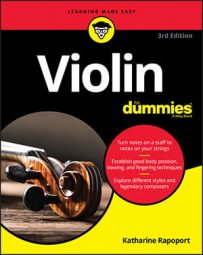When you meet some double stops in music, as a violinist, you need to be comfortable going from playing on a single string to playing on two strings at once— and then back again. The exercises below take you through the stages for making a smooth transition between strings.
With separate bows
One situation you encounter often in double stops is switching from one string to two strings (and then back to one again) just as you change bow direction. This maneuver takes a little finesse with the bow levels.
The exercise below shows you how to go from the D string to the Dand A strings together, and then back again, using separate bows. Here are the steps:
Finish an up-bow on the second D, and at the same time, allow the bow’s level to start adjusting closer to the A string so that the level change is minimal when you begin your new down-bow on the DandA strings together.
Start to float the bow’s level over toward the D string when you’re nearing the end of the up-bow (on the second D and A together).
Now you’re as close as possible to the new bow level that you need to be on for the new down-bow on D alone.
Play the double stops that follow in the exercise in the way as described in Steps 1 and 2, but add the new finger on the A string ahead of the bow, because adding the finger a bit sooner won’t get in the way of your sound.
When adding a new finger and switching from one string to two strings in double stops, the old finger may remain lightly on the string— if it isn’t in the way.
Keep these points in mind:
If you’re crossing to a higher-sounding string (such as from D to A): Lead the level-change with your elbow, releasing slightly downward, and then let your arm and hand follow the wave of movement.
If you’re crossing to a lower-sounding string (such as from E to G): Lead the level-change with your hand floating slightly upward, and then let your arm and elbow follow the wave of movement.
Adjusting levels may feel quite contrary at first, but it soon becomes second nature.

With slurred bows
Sometimes, the music calls for you to go from one string to two strings (and then back again) all in the same bow stroke. So as you’re about to play the double stop, your bow doesn’t change direction.
The trick to smooth transitions with slurred bows is to find the bow level closest to the next string you’re going to play — very sneaky! For example, if you’re bowing on your D string and the next note is on the G string, allow the bow to lean toward the level of the G string. Don’t let the bow go anywhere near the A string!
The distances don’t look like much, but they cost you time in travel. Prepare your bow levels wisely for smooth transitions. (Because violinists are a bunch of wise guys, this technique should suit you just fine.)
The figure below shows you some slurred examples of getting into double stops. Playing slurred double stops calls for knowing your bow levels really well so that you don’t make bumpy transitions across the strings. Here are the steps for the first pair of strings, D and A.
Start a down-bow at the frog on the open D string, bowing steadily at a very relaxed pace.
Start lowering your right arm level slightly as you approach the midpoint of the bow, to bring the bow hair almost onto the A string.
Continue the down-bow direction, but just as you reach the middle of the bow, allow the bow to make a full transition toward the A string so that the bow is equally balanced to sound both the D and A strings together.
Begin the smooth up-bow on exactly the same level at the tip of the bow, sounding the D and A strings together and keeping the same bow speed you use for the down-bow that starts in Step 1.
Start floating up your right hand (your arm’s level follows) as you approach the midpoint of the bow, to prepare for the transition to the D string.
Continue the up-bow direction and then allow the bow to make a full transition to playing the D string alone just as you reach the middle of the bow.
Land the next finger on the A string for each double stop on the A while bowing the open D string alone in the subsequent measures.
 Going from one string to two and then back again (slurred bows).
Going from one string to two and then back again (slurred bows).
Follow the same sequence of steps for the other pairs of strings, which you can try off your own bat (or bow!).

